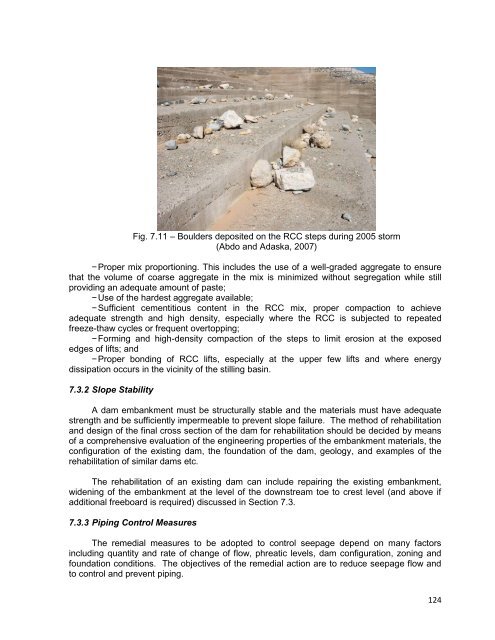SMALL DAMS PETITS BARRAGES
SMALL DAMS PETITS BARRAGES
SMALL DAMS PETITS BARRAGES
- TAGS
- dams
- petits
- barrages
- cbdb.org.br
You also want an ePaper? Increase the reach of your titles
YUMPU automatically turns print PDFs into web optimized ePapers that Google loves.
Fig. 7.11 – Boulders deposited on the RCC steps during 2005 storm<br />
(Abdo and Adaska, 2007)<br />
− Proper mix proportioning. This includes the use of a well-graded aggregate to ensure<br />
that the volume of coarse aggregate in the mix is minimized without segregation while still<br />
providing an adequate amount of paste;<br />
− Use of the hardest aggregate available;<br />
− Sufficient cementitious content in the RCC mix, proper compaction to achieve<br />
adequate strength and high density, especially where the RCC is subjected to repeated<br />
freeze-thaw cycles or frequent overtopping;<br />
− Forming and high-density compaction of the steps to limit erosion at the exposed<br />
edges of lifts; and<br />
− Proper bonding of RCC lifts, especially at the upper few lifts and where energy<br />
dissipation occurs in the vicinity of the stilling basin.<br />
7.3.2 Slope Stability<br />
A dam embankment must be structurally stable and the materials must have adequate<br />
strength and be sufficiently impermeable to prevent slope failure. The method of rehabilitation<br />
and design of the final cross section of the dam for rehabilitation should be decided by means<br />
of a comprehensive evaluation of the engineering properties of the embankment materials, the<br />
configuration of the existing dam, the foundation of the dam, geology, and examples of the<br />
rehabilitation of similar dams etc.<br />
The rehabilitation of an existing dam can include repairing the existing embankment,<br />
widening of the embankment at the level of the downstream toe to crest level (and above if<br />
additional freeboard is required) discussed in Section 7.3.<br />
7.3.3 Piping Control Measures<br />
The remedial measures to be adopted to control seepage depend on many factors<br />
including quantity and rate of change of flow, phreatic levels, dam configuration, zoning and<br />
foundation conditions. The objectives of the remedial action are to reduce seepage flow and<br />
to control and prevent piping.<br />
124














